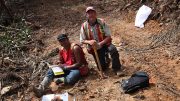Goldsource Mines (TSXV: GXS) is rapidly advancing the Eagle Mountain project in Guyana, the country’s second-largest undeveloped gold deposit, CEO Steve Parsons tells The Northern Miner in an interview.
On February 22, the Canada-based company published a new National Instrument 43-101 resource estimate update on the project, essentially doubling the indicated and inferred resource categories to just more than 1.7 million oz. gold. It is a milestone Parsons declares lends the project critical mass to move forward and for the company to contemplate a starter scenario on the expansive and highly prospective project.
The new resource estimate entails about 23 million tonnes grading 1.14 grams per tonne gold for 848,000 oz. of gold in the indicated category, and 25 million tonnes grading 1.09 grams per tonne gold for 868,000 oz. inferred.
Guyana was recently thrust back under the global mining investment spotlight. Gran Colombia Gold (TSX: GCM) announced in mid-March an all-scrip $315 million (US$252.5 million) transaction through which it is acquiring Gold X Mining (TSXV: GLDX) and its Toroparu project.
Toroparu is in Western Guyana’s Cuyuni-Mazaruni region and is the most extensive undeveloped copper-gold resource base in Guyana, with measured and indicated resources of 7.4 million oz. gold in 252.6 million tonnes grading 0.91 grams gold. The project lies in Gold X’s 532.8-sq.-km Upper Puruni concession.
Goldsource’s recent resource update consolidated the consistent exploration effort over the past several years. It includes the Eagle Mountain and Salbora deposits, which feature gold mineralisation starting at surface in saprolite (soft rock) and extends into the underlying fresh rock. The saprolite is estimated to contain 42% of the gold in indicated resources and 16% gold in inferred resources.

The Eagle Mountain project has several oxidation domains which bode well for a low-cost starter scenario. (Credit: Goldsource Mines)
The resource estimate employed cut-off grades of 0.3 grams per tonne gold for the saprolite and 0.5 grams per tonne for the fresh rock, held within a conceptual open pit. Gold in surface saprolite and the shallow sub-horizontal zones of the Eagle Mountain deposit results in a low average strip ratio. The strip ratio of the saprolite is estimated to be below 1:1, notes Parsons.
The updated resource was defined by a total of 674 core holes for 57,550 metres drilled and 158 auger drill holes for 532 metres drilled, which includes infill and exploration drilling up to November 6, 2020.
Compared against the 2014 preliminary economic assessment (PEA), the updated resource delivers a 349% increase in gold in indicated resources and a 9% increase in gold held in inferred resources.
Parsons says additional infill and expansion drilling since the 2014 PEA contributed to the significant increase in indicated resources while discovering the Salbora deposit and extensions to the Eagle Mountain deposit with the Friendly and No. 1 Hill areas being added to mineral resources.
The company is planning a second resource update in the second half of 2021. This will incorporate expansionary and infill drilling results at the Eagle Mountain deposit, including the Baboon and Ounce Hill areas, and exploration drilling along the prospective Salbora-Powis trend targeting Salbora-style mineralisation.
“We’ve known that Eagle Mountain will be scalable all along, but now we have confirmed that critical mass of mineralisation we needed to plan for the next phase,” says the company’s president, Ioannis Tsitos.
Since 2019, the company’s objective has been to expand and upgrade mineral resources at the Eagle Mountain project, targeting an interim mineral resource of between 1.3 million and 1.6 million ounces, with a grade greater than 1.0 grams per tonne gold hosted in shallow open pits. The exploration program over this period included more than 30,000 metres of drilling.

An Eagle Mountain worker cutting core. (Credit: Goldsource Mines)
With the significant milestone in hand, there is no time to rest in the higher gold price environment, says Parsons.
The company is already hard at work to achieve the five main objectives for the 2021 drill programme. This includes prioritising exploration drilling at several new target areas along with the Salbora‐Powis trend, such as the Toucan, Powis, Ann and Montgomery prospects where the potential exists for Salbora‐style mineralisation.
Objectives also include testing for new lateral extensions of the dip slope sub‐horizontal zones of the Eagle Mountain deposit, including Baboon, No.1 Hill and Ounce Hill, and to the north, west and southwest currently outside of the 2021 resource estimate; conduct further infill drilling of the 2021 resource to upgrade as much of the inferred resource to the measured and indicated categories; compile 2021 data; and pursue potential geological, geophysical and other geoscientific studies and analyses that will assist the company in prioritising target areas near the company’s prospecting licence.
Parsons says the upcoming resource estimate will be used as a basis for a prefeasibility study on a low cost large‐scale, 4,000 to 5,000 tonnes per day open pit gold mining operation. The company has recently closed an over-subscribed private placement of 115 million units at 11c each for $12.65 million to fund the work. The units comprised one Goldsource share and one-half a share purchase warrant exercisable at 14c per share until May 20, 2023.
“We will evaluate opportunities for a phased development plan, specifically with initial and baseline production provided by soft‐rock saprolite material followed by an expansion to incorporate the fresh rock mineralisation. The PFS is expected to be delivered in 2022,” Parsons says.
Three drill rigs are currently operating at the Eagle Mountain gold project. The company plans to complete 16,500 metres of drilling in 2021, of which 8,728 metres have been drilled, with about 40% to 50% of the budgeted metres earmarked for infill drilling of the February 2021 resource.





Be the first to comment on "Goldsource seeks to chart scalable development of Eagle Mountain"